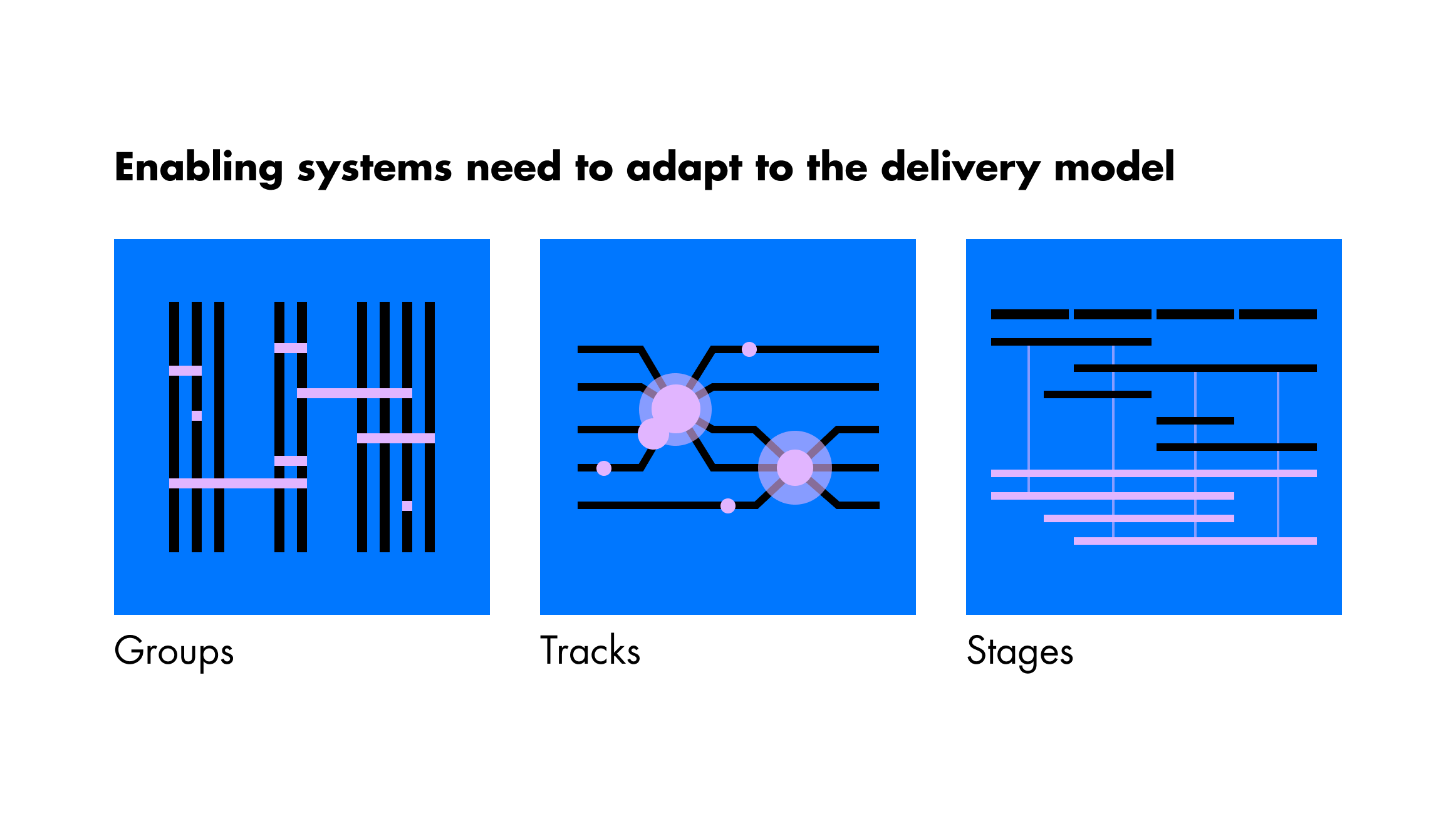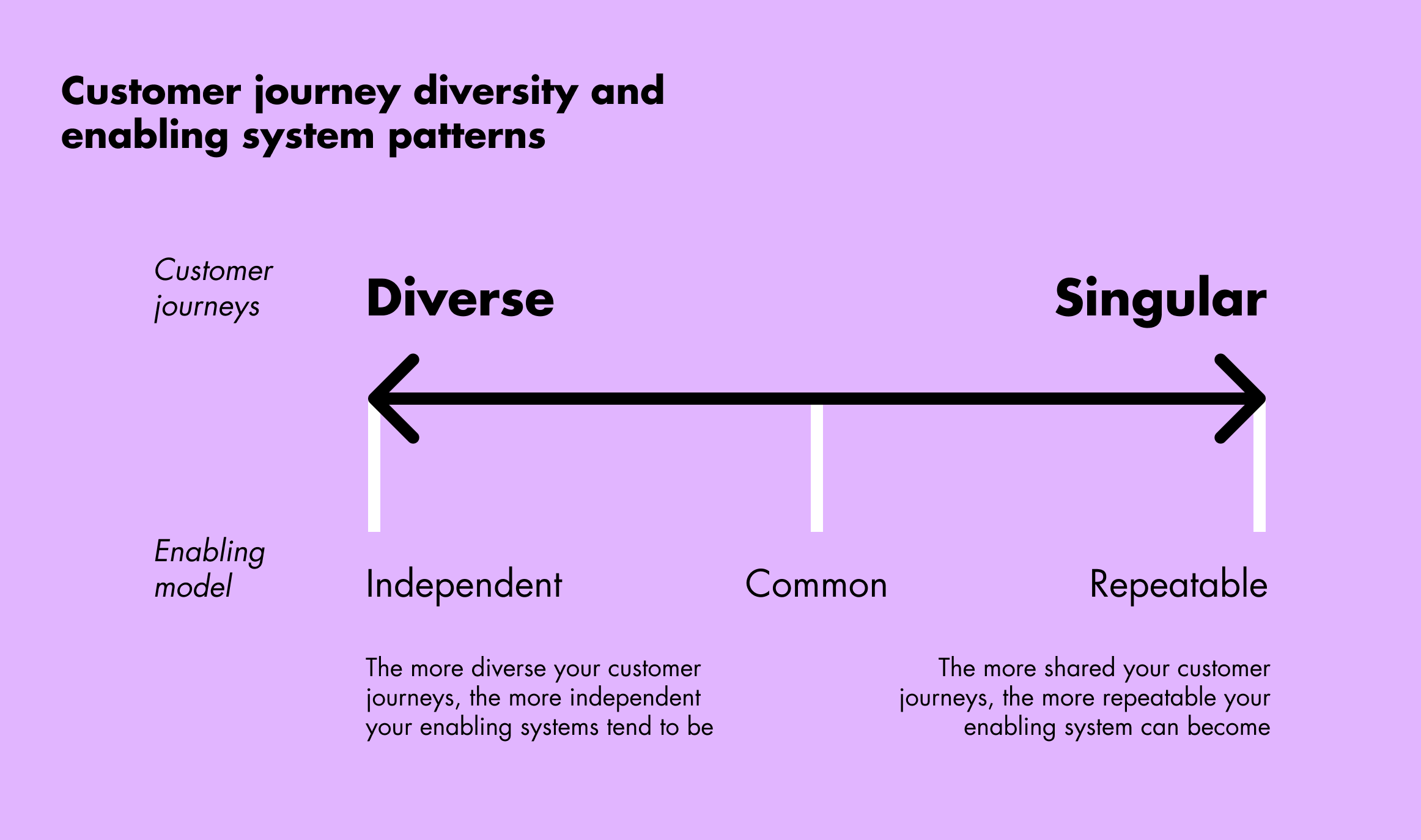The invisible systems that power delivery
The most effective operating models start with delivery. They’re built around delivering value to customers through products and services. (You can read more about that in my previous post: Forget the org chart. Start with delivery.)
Behind every strong delivery model is an invisible ecosystem. For products and services to work at scale, they need the right enablers: platforms, data, and capabilities that power delivery.
Your delivery model defines how your organisation creates value, by focusing on the products and services that matter most.
Your enabling system ensures delivery works efficiently, reliably, and coherently.
What enables delivery
Every large organisation needs enabling systems that sit behind delivery.
These include the internal products and services that support operations, the platforms and systems that create the underlying infrastructure, the operational capabilities that create workflows, and the data that informs learning and decisions.
But not all enablers should work in the same way.
Some should be repeatable, shared and used everywhere.
Others should be common, shared where it makes sense.
And some should stay independent, designed for the specific needs of a product or service.
The goal isn’t to make everything uniform.
It’s to design the right balance of repeatable, common, and independent enablers based on how your organisation delivers value.
That balance matters commercially. It’s what drives speed to market, a better customer experience, and a more efficient operation.
A pattern that shows up everywhere
When you look across organisations, a clear pattern emerges:
The more diverse your customer journeys, the more independent your enabling systems tend to be.
The more shared your customer journeys, the more repeatable your enabling system can become.
Trying to drive efficiency through repeatability and consistency isn’t possible if your customer journeys are necessarily diverse. Many organisations push for efficiency before achieving system-wide coherence. The result is shared systems that slow everyone down instead of speeding them up. Recognising the relationship between diversity and repeatability changes how you approach scale.
How the delivery model shapes the enabling systems
The right mix of enablers depends on the kind of delivery model you have.
I wrote about the 3 types of delivery-centred operating models in my last blog post.
Group models
(Such as a retailer with food, fashion, and home businesses.)
Group models thrive on focus. They need autonomy to optimise for different customers groups and journeys. Enablers are often independent across the businesses, with only shared infrastructure and brand coherence at the edges. The opportunity is to look for selective commonality – shared platforms, processes, or data that simplify the operation without constraining autonomy.
Track models
(For example, a health or leisure business with overlapping services.)
Track models thrive on connection. They’ll have repeat customers across their products and services, with lots of overlaps between customer journeys. They need common and shared platforms, capabilities, and data where journeys overlap. The challenge is to push for greater commonality without losing the ability for each service to meet its customer needs, balancing local value with overall coherence.
Stage models
(Like a university with long learner journeys.)
Stage models thrive on orchestration. The same customer moves through multiple stages over longer periods of time, so consistency and reliability are critical. Enablers are typically repeatable across the customer journey, supporting a deep, interconnected operation. The opportunity is to build tight integration and shared systems that make the whole experience feel coherent end to end.
It’s important to say this isn’t about size or complexity.
A group model might look more complex on paper, but each part can operate relatively independently.
A stage model might look simpler - one long customer journey - but it demands a much deeper and more interconnected operation to make that journey work end-to-end.
Each model carries a different shape of complexity: groups manage variety, stages manage depth.
The real scalability trade-off
The more connected your customer journeys are, the more your operations can lean on shared and repeatable systems.
That brings efficiency, but it also increases interdependence.
Groups focus on autonomy and individual performance, managing many smaller, faster systems.
Tracks optimise for flow and coherent touchpoints, integrating overlapping services without slowing them down.
Stages rely on consistency and reliability, running a deep interconnected operation that serves everyone.
The more shared the system, the more tightly it must be orchestrated.
The more independent the system, the more alignment you need at the edges.
When you step back, together these patterns form an operational ecosystem: the systems, capabilities, and enablers that keep the organisation running and delivering for customers. Each part influences the others. The strength of an enabling model isn’t in its surface design, but in how the elements connect and adapt as a whole. When it works well, the ecosystem becomes self-correcting. Delivery bottlenecks reveal where the enabling system needs to adapt, and the enablers evolve in service of delivery.
Governance, leadership, teams, and decision-making all play a vital role in how this ecosystem works in practice. They shape how well it’s led, how fast it learns, and how connected it stays to delivery. Those are equally critical parts of the operating model (and will be the focus of a separate series).
Designing your enabling model
An operating model’s strength lies in how its products and services are enabled to deliver value.
For each system, capability, or platform, ask yourself:
Should this be repeatable - the same for most products and services?
Should it be common - shared where journeys overlap?
Or should it be independent - tailored to specific needs?
Whether it’s an internal service, a shared platform, a skillset, or a data layer, knowing which of these it is helps you scale intentionally.
From delivery to enabling
Start with delivery to centre the organisation around how value is created and delivered.
Then design what enables the operation to run smoothly and efficiently.
Shared doesn’t always mean efficient.
Independence isn’t always wasteful.
The right balance between delivery and enabling is what makes the operating model, and the organisation, work as a connected and ever-evolving system.




